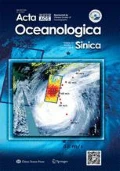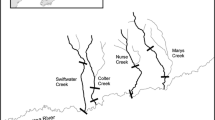Abstract
In the survey of fishery resources, the sampling design will directly impact the accuracy of the estimation of the abundance. Therefore, it is necessary to optimize the sampling design to increase the quality of fishery surveys. The distribution and abundance of fisheries resource estimated based on the bottom trawl survey data in the Changjiang River (Yangtze River) Estuary-Hangzhou Bay and its adjacent waters in 2007 were used to simulate the “true” situation. Then the abundance index of Portunus trituberculatus were calculated and compared with its true index to evaluate the impacts of different sampling designs on the abundance estimation. Four sampling methods (including fixed-station sampling, simple random sampling, stratified fixed-station sampling, and stratified random sampling) were simulated. Three numbers of stations (9, 16 and 24) were assumed for the scenarios of fixed-station sampling and simple random sampling without stratification. While 16 stations were assumed for the scenarios with stratification. Three reaction distances (1.5 m, 3 m and 5 m) of P. trituberculatus to the bottom line of trawl were also assumed to adapt to the movement ability of the P. trituberculatus for different ages, seasons and substrate conditions. Generally speaking, compared with unstratified sampling design, the stratified sampling design resulted in more accurate abundance estimation of P. trituberculatus, and simple random sampling design is better than fixed-station sampling design. The accuracy of the simulated results was improved with the increase of the station number. The maximum relative estimation error (REE) was 163.43% and the minimum was 49.40% for the fixed-station sampling scenario with 9 stations, while 38.62% and 4.15% for 24 stations. With the increase of reaction distance, the relative absolute bias (RAB) and REE gradually decreased. Resource-intensive area and the seasons with high density variances have significant impacts on simulation results. Thus, it will be helpful if there are prior information or pre-survey results about density distribution. The current study can provide reference for the future sampling design of bottom trawl of P. trituberculatus and other species.
Similar content being viewed by others
References
Anonymous. 2018. Piloting marine limit fishing and promoting the total control of fishery resources—Introduction to the pilot work of marine quota fishing in the five provinces. Journal of Fisheries of China (in Chinese), (9): 2–4
Cabral H, Murta A. 2004. Effect of sampling design on abundance estimates of benthic invertebrates in environmental monitoring studies. Marine Ecology Progress, 276(1): 19–24
Chen Y. 1996. A monte carlo study on impacts of the size of sub-sample catch on estimation of fish stock parameters. Fisheries Research, 26(3–4): 207–223, doi: https://doi.org/10.1016/0165-7836(95)00447-5
Chen Yong, Sherman S, Wilson C, et al. 2006. A comparison of two fishery-independent survey programs used to define the population structure of American Lobster (Homarus americanus) in the Gulf of Maine. Fishery Bulletin, 104(2): 247–255
Cheng Guobao, Shi Huilai, Lou Bao, et al. 2012. Biological characteristics and artificial propagation, culture technique for Portunustrituberculatus. Hebei Fisheries (in Chinese), (4): 59–61
Cochran W G. 1977. Sampling Techniques. 3rd ed. New York: John Wiley & Sons
Conners M E, Schwager S J. 2002. The use of adaptive cluster sampling for hydroacoustic surveys. ICES Journal of Marine Science, 59(6): 1314–1325, doi: https://doi.org/10.1006/jmsc.2002.1306
Cressie N A C. 1993. Statistics for Spatial Data. New York: John Wiley and Sons
Dai Aiyun, Feng Zhongqi, Song Yuzhi, et al. 1977. Preliminary survey of biology of Portunus trituberculata. Chinese Journal of Zoology (in Chinese), (2): 30–33
Department of Fisheries, Ministry of Agriculture, Animal Husbandry and Fisheries. 1987. Investigation and Division of Fishery Resources in the East China Sea (in Chinese). Shanghai: East China Normal University Press
Ding Zhangni, Xu Yongjian, Lin Jianhua, et al. 2014. Effects of salinity on feeding behavior and growth characteristics of swimming crab Portunus trituberculatus. Journal of Ecological Science (in Chinese), 33(5): 899–903
Fisheries and Fisheries Administration of the Ministry of Agriculture. 2017. China Fishery Statistical Yearbook (in Chinese). Beijing: China Agriculture Press, 224
Gavaris S, Smith S J. 1987. Effect of allocation and stratification strategies on precision of survey abundance estimates for Atlantic Cod (Gadus morhua) on the Eastern Scotian Shelf. Journal of Northwest Atlantic Fishery Science, 7: 137–144, doi: https://doi.org/10.2960/J.v7.a16
Gou Penghuang. 2005. Some considerations stratified sampling. Statistical Research (in Chinese), (11): 16–17
Huang Jinling, Huang Shuolin. 2002. A study on feasibility of implementing total allowable catch in Chinese EEZ. Modern Fisheries Information (in Chinese), 17(11): 3–6
Jardim E, Ribeiro P J Jr. 2007. Geostatistical assessment of sampling designs for Portuguese bottom trawl surveys. Fisheries Research, 85(3): 239–247, doi: https://doi.org/10.1016/j.fishres.2007.02.014
Jin Yongjin, Du Zifang, Jiang Yan. 2008. Sampling Technique (in Chinese). 2nd ed. Beijing: China Renmin University Press
Lai Hanlin, Kimura D K. 2002. Analyzing survey experiments having spatial variability with an application to a sea scallop fishing experiment. Fisheries Research, 56(3): 239–259, doi: https://doi.org/10.1016/S0165-7836(01)00323-X
Li Jinchang. 2010. Application of Sampling Techniques (in Chinese). 3rd ed. Beijing: Science Press
Li Bai, Cao Jie, Chang Juihan, et al. 2015. Evaluation of effectiveness of fixed-station sampling for monitoring American lobster settlement. North American Journal of Fisheries Management, 35(5): 942–957, doi: https://doi.org/10.1080/02755947.2015.1074961
Li Fan, Li Xiansen, Zhao Xianyong. 2008. Bottom trawl survey data analysis based on Delta-distribution model and its application in the estimation of small yellow croak and silver pomfret in Yellow Sea. Journal of Fisheries of China (in Chinese), 32(1): 145–151
Liu Yong. 2012. Theoretical study on the sampling methods of survey for fishery stock estimation (in Chinese) [dissertation]. Shanghai: East China Normal University
Liu Bin. 2016. Effect of the temperature on the behavior of the Portunus trituberculatus. Hebei Fisheries (in Chinese), (3): 4–5
Liu Yong, Chen Yong, Cheng Jiahua. 2009. A comparative study of optimization methods and conventional methods for sampling design in fishery-independent surveys. ICES Journal of Marine Science, 66(9): 1873–1882, doi: https://doi.org/10.1093/icesjms/fsp157
Manly B F J, Akroyd J A M, Walshe K A R. 2002. Two-phase stratified random surveys on multiple populations at multiple locations. New Zealand Journal of Marine and Freshwater Research, 36(3): 581–591, doi: https://doi.org/10.1080/00288330.2002.9517114
Miller T J, Skalski J R, Ianelli J N. 2007. Optimizing a stratified sampling design when faced with multiple objectives. ICES Journal of Marine Science, 64(1): 97–109, doi: https://doi.org/10.1093/icesjms/fs1013
Overholtz W J, Jech J M, Michaels W L, et al. 2006. Empirical comparisons of survey designs in acoustic surveys of Gulf of Maine-Georges Bank Atlantic Herring. Journal of Northwest Atlantic Fishery Science, 36: 127–144, doi: https://doi.org/10.2960/J.v36.m575
Pennington M. 1996. Estimating the mean and variance from highly skewed marine. Fishery Bulletin, 94(3): 498–505
Petitgas P. 2010. Geostatistics in fisheries survey design and stock assessment: Models, variances and applications. Fish and Fisheries, 2(3): 231–249
Pokhrel R M, Kuwano J, Tachibana S. 2013. A kriging method of interpolation used to map liquefaction potential over alluvial ground. Engineering Geology, 152(1): 26–37, doi: https://doi.org/10.1016/j.enggeo.2012.10.003
Rivoirard J, Simmonds J, Foote K G, et al. 2008. Geostatistics for Estimating Fish Abundance. Oxford, UK: John Wiley and Sons
Simmonds E J, Fryer R J. 1996. Which are better, random or systematic acoustic surveys? A simulation using North Sea herring as an example. ICES Journal of Marine Science, 53(1): 39–50, doi: https://doi.org/10.1006/jmsc.1996.0004
Skibo K M, Schwarz C J, Peterman R M. 2008. Evaluation of sampling designs for red sea urchins strongylocentrotus franciscanus in British Columbia. North American Journal of Fisheries Management, 28(1): 219–230, doi: https://doi.org/10.1577/M06-293.1
Smith D R. 2006. Survey design for detecting rare freshwater mussels. Journal of the North American Benthological Society, 25(3): 701–711, doi: https://doi.org/10.1899/0887-3593(2006)25[701:SDFDRF]2.0.CO;2
Smith S J, Gavaris S. 1993. Improving the precision of abundance estimates of Eastern Scotian Shelf Atlantic Cod from bottom trawl surveys. North American Journal of Fisheries Management, 13(1): 35–47, doi: https://doi.org/10.1577/1548-8675(1993)013<0035:ITPOAE>2.3.CO;2
Song Haitang, Ding Yueping, Xu Yuanjian. 1988. A study on the breeding habits of blue crab (Portuns trituberculalus miers) in the northern coastal waters of Zhejiang. Journal of Zhejiang Ocean University (Natural Science) (in Chinese), (1): 39–46
Song Haitang, Yu Cungen, Xue Lijian, et al. 2006. East China Sea Economic Shrimp and Crabs (in Chinese). Beijing: China Ocean Press
Stein A, Ettema C. 2003. An overview of spatial sampling procedures and experimental design of spatial studies for ecosystem comparisons. Agriculture, Ecosystems & Environment, 94(1): 31–47
Sun Jie. 2018. Study on prediction model of natural supplementary resources of Portunus trituberculatus in the Northern Sea Area of Zhejiang Province (in Chinese) [dissertation]. Zhoushan: Zhejiang Ocean University
Wang Yingbin, Jiao Yan. 2015. Estimating time-based instantaneous total mortality rate based on the age-structured abundance index. Chinese Journal of Oceanology and Limnology, 33(3): 559–576, doi: https://doi.org/10.1007/s00343-015-4112-z
Wang Jiaqi, Tian Siquan, Gao Chunxia, et al. 2018. Optimization of sample size for lake fish resources survey. Journal of Shanghai Ocean University (in Chinese), 27(2): 265–273
Wu Qiang, Wang Jun, Chen Ruisheng, et al. 2016. Biological characteristics, temporal-spatial distribution of Portunus trituberculatus and relationships between its density and impact factors in Laizhou Bay, Bohai Sea, China. Chinese Journal of Applied Ecology (in Chinese), 27(6): 1993–2001
Xu Binduo, Ren Yiping, Chen Yong, et al. 2015. Optimization of stratification scheme for a fishery-independent survey with multiple objective. Acta Oceanologica Sinica, 34(12): 154–169, doi: https://doi.org/10.1007/s13131-015-0739-z
Yu Cungen. 2011. Zhoushan Fishing Ground Fishery Ecology. Beijing: Science Press
Yu Hao, Jiao Yan, Su Zhenming, et al. 2012. Performance comparison of traditional sampling designs and adaptive sampling designs for fishery-independent surveys: A simulation study. Fisheries Research, 113(1): 173–181, doi: https://doi.org/10.1016/j.fishres.2011.10.009
Yuan Xingwei, Jiang Yazhou, Yan Liping. 2009. Comparison on difference of the stock density of Psenopsis anomala in the East China Sea by means of different estimating methods. Marine Fisheries (in Chinese), 31(1): 10–15
Yuan Xingwei, Liu Yong, Cheng Jiahua. 2011. Error analysis on stratified sampling and its application in fishery statistics. Marine Fisheries (in Chinese), 33(1): 116–120
Zhang Qiyong, Hong Wanshu, Chen Shixi. 2017. Stock changes and resource protection of the large yellow croaker (Larimichthys crocea) and ribbon fish (Trichiurus Japonicus) in coastal waters of China. Journal of Applied Oceanography (in Chinese), 36(3): 438–445
Zhao Jing, Zhang Shouyu, Lin Jun, et al. 2014. A comparative study of different sampling designs in fish community estimation. Chinese Journal of Applied Ecology (in Chinese), 25(4): 1181–1187
Zheng Yuanjia. 2003. East China Sea Continental Shelf Biological Resources and Environment (in Chinese). Shanghai: Shanghai Science and Technology Press
Acknowledgements
We are grateful for all scientific staff and crew for their assistance with data collection during all the surveys.
Author information
Authors and Affiliations
Corresponding author
Additional information
Foundation item: The National Key Research and Development Program of China under contract No. 2017YFA0604902; the Science and Technology Project of Zhoushan under contract No. 2017C41012.
Rights and permissions
About this article
Cite this article
Sun, C., Wang, Y. Impacts of the sampling design on the abundance index estimation of Portunus trituberculatus using bottom trawl. Acta Oceanol. Sin. 39, 48–57 (2020). https://doi.org/10.1007/s13131-020-1607-z
Received:
Accepted:
Published:
Issue Date:
DOI: https://doi.org/10.1007/s13131-020-1607-z



